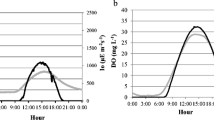Abstract
A deterministic simulation model was developed to predict production rates of the marine prymnesiophyteIsochrysis galbana in an outdoor algal mass culture system. The model consists of photoadapation, gross photosynthesis and respiration sections. Actual physiological and biophysical laboratory data, obtained from steady state cultures grown under a wide range of irradiance levels, were used in calculating productivity. The resulting values were used to assess optimal operational parameters to maximize algal biomass production. The model predicted a yearly averaged production rate of 9.7 g C m−2d−1, which compared well with field data reported in the literature. The model evaluated the effect of pond depth and chlorophyll concentration on potential production rate in various seasons. The model predicted that a yearly averaged chlorophyll areal density of 0.65 g m−2 will yield the maximal production rate. Chlorophyll areal density should be seasonally adjusted to give maximal production. This adjustment could be done either by changing pond depth or chlorophyll concentration. The model predicted that under optimal operational conditions, the diurnal respiration losses averaged 35% of gross photosynthesis. The calculated growth rate for maximal productivity ranged between 0.15 and 0.24 d−1, suggesting an optimal hydraulic retention time of 6.7 and 4.2 d for various seasons.
Similar content being viewed by others
References
Azov Y, Shelef G (1982) Operation of high rate oxidation ponds: theory and experiments. Water Res. 16: 1153–1160.
Ben-Amotz A, Avron M (1989) The biotechnology of mass culturingDunaliella for products of commercial interest. In Crosswell RC, Rees TAV, Shah N (eds), Algal and Cyanobacterial Biotechnology. Longman Scientific & Technical Press, London, 90–114.
Berner T, Dubinsky Z, Wayman K, Falkowski PG (1989) Photoadaptation and the "package" effect inDunaliella tertiolecta (Chlorophyceae). J. Phycol. 25: 70–78.
Borowitzka MA, Borowitzka LJ (1988) Microalgal biotechnology. Cambridge University Press, New York, 390 pp.
Boussiba S, Sandbank E, Shelef G, Cohen Z, Vonshak A, Ben-Amotz A, Arad S, Richmond A (1988) Outdoor cultivation of the marine microalgaeIsochrysis galbana in open reactors. Aquaculture 72: 247–253.
Burlew JS (1953) Algal culture from laboratory to pilot plant. Carnegie Institution of Washington, Washington D.C., 360 pp.
De Pauw N, Morales J, Persoone G (1984) Mass culture of microalgae in aquaculture systems: progress and constraints. Hydrobiologia 116/117: 121–134.
Dubinsky Z, Falkowski PG, Wyman K (1986) Light harvesting and utilization by phytoplankton. Plant Cell Physiol. 27: 1335–1349.
Falkowski PG (1980) Light shade adaptation in microalgae. In Falkowski PG (ed.), Primary Productivity in the Sea. Plenum Press, New York, 99–119.
Falkowski PG (1984) Kinetics of adaptation to irradiance inDunaliella tertiolecta. Photosynthetica 18: 62–68.
Falkowski PG Dubinsky Z, Wyman K (1985) Growth-irradiance relationships in phytoplankton. Limnol. Oceanogr. 30: 311–321.
Gates DM (1980) Biophysical Ecology. Springer Verlag, New York 320 pp.
Grobbelaar JU, Soeder CJ, Stengel E (1990) Modeling algal productivity in large outdoor cultures and waste treatment system. Biomass 21: 297–314.
Guillard RL, Ryther JH (1962) Studies of marine planktonic diatoms. I.Cyclotella nana Hustedt, andDetonula confervacea (Cleve) Gran. Can. J. Microbiol. 8: 229–239.
Hartig P, Grobbelaar JU, Soeder CJ, Groeneweg J (1988) On the mass culture of microalgae: Areal density as an important factor for achieving maximal productivity. Biomass 15: 211–221.
Herzig R, Falkowski PG (1989) Nitrogen limitation inIsochrysis galbana (Haptophyceae). I. Photosynthetic energy conversion and growth efficiencies. J. Phycol. 25: 462–471.
Oswald, WJ (1988) Large scale algal culture systems (engineering aspects). In Borowitzka MA, Borowitzka LJ (eds), Microalgal Biotechnology. Cambridge Univ. Press, Cambridge, 357–394.
Richardson K, Beardall J, Raven JA (1984) Adaptation of unicellular algae to irradiance: an analysis of strategies. New Phytol. 93: 157–191.
Richmond A (1986) CRC Handbook of Microalgae Mass Culture. CRC Press Inc., Boca Raton, Florida, 528 pp.
Richmond A, Grobbelaar JU (1986) Factors affecting the output rate ofSpirulina platensis with reference to mass cultivation. Biomass 10: 253–264.
Soeder CJ (1980) Massive cultivation of microalgae: results and prospects. Hydrobiologia 72: 197–209.
Sukenik A, Bennett J, Mortain-Bertrand A, Falkowski PG (1990) Adaptation of the photosynthetic apparatus to irradiance inDunaliella tertiolecta, a kinetic study. Plant Physiol. 92: 891–896.
Sukenik A, Falkowski PG, Bennett J (1987) Potential enhancement of photosynthetic energy conversion in algal mass culture. Biotechnol. Bioengng. 30: 970–977.
Sukenik A, Wahnon R (1991) Biochemical quality of marine unicellular algae with special emphasis on lipid composition. I.Isochrysis galbana. Aquaculture (in press).
Talling JF (1957) The phytoplankton population as a compound photosynthetic system. New Phytol. 56: 29–50.
Author information
Authors and Affiliations
Rights and permissions
About this article
Cite this article
Sukenik, A., Levy, R.S., Levy, Y. et al. Optimizing algal biomass production in an outdoor pond: a simulation model. J Appl Phycol 3, 191–201 (1991). https://doi.org/10.1007/BF00003577
Received:
Revised:
Accepted:
Issue Date:
DOI: https://doi.org/10.1007/BF00003577




